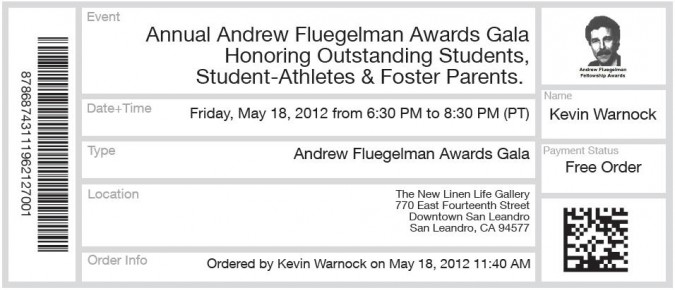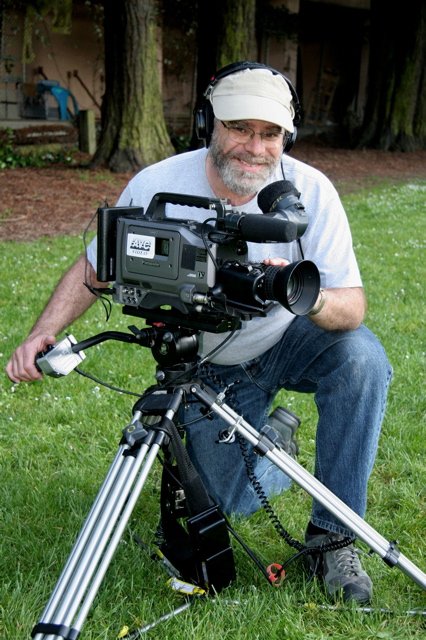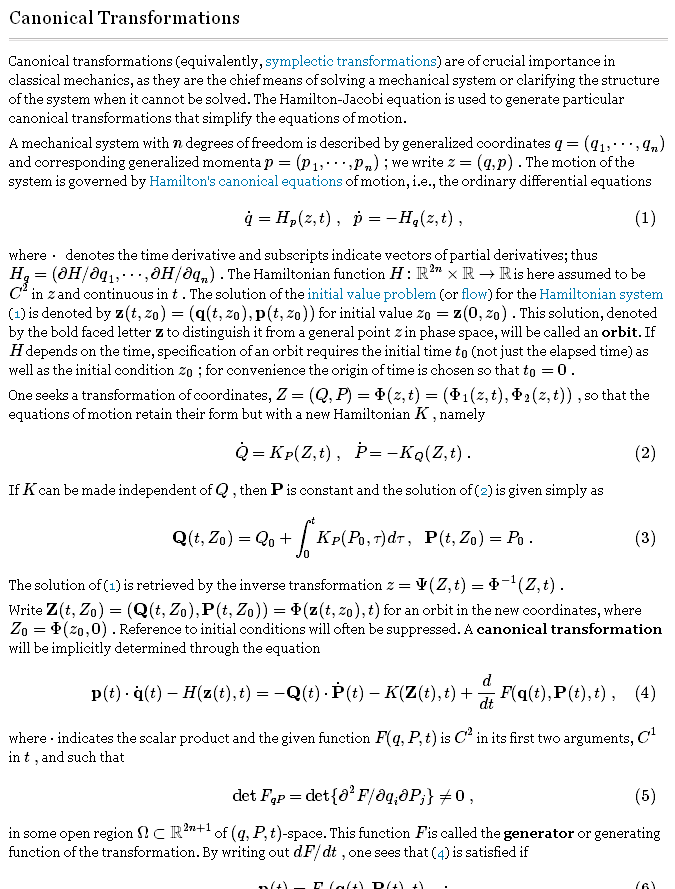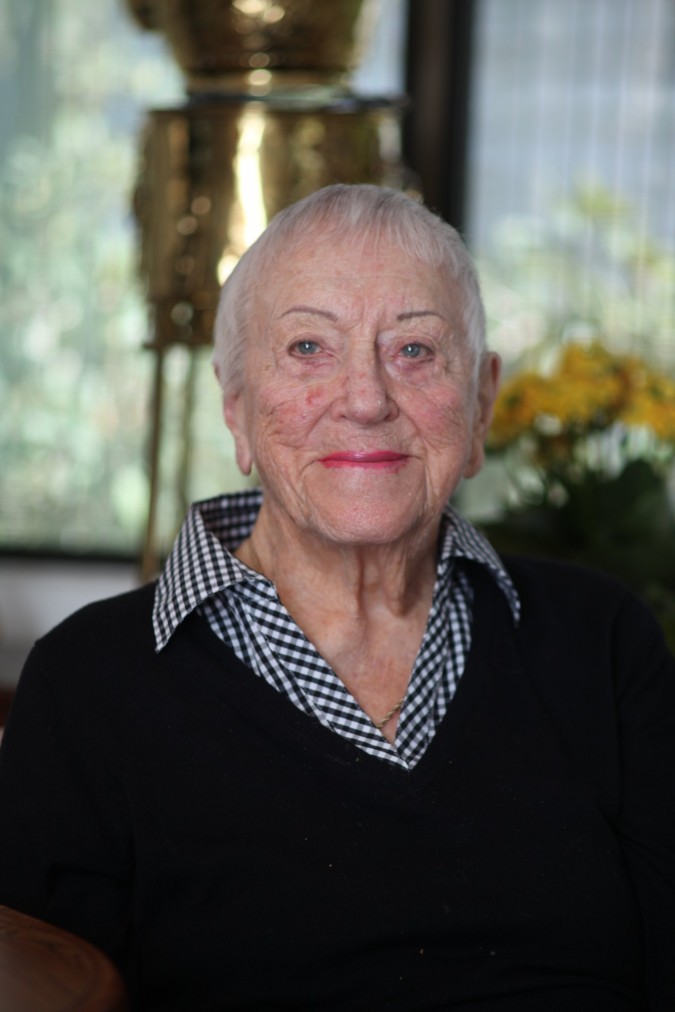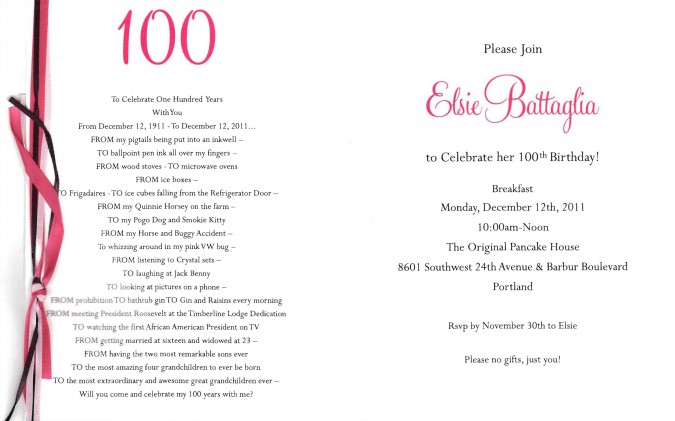Archive for the ‘Family’ Category
Why in 1978 I moved to San Francisco from Chicago
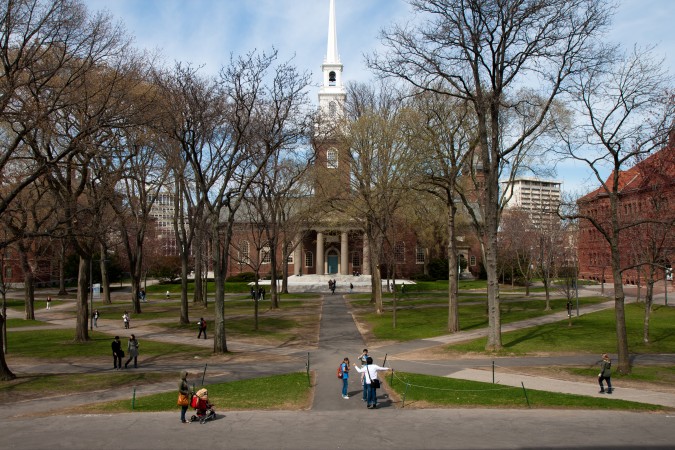
The Memorial Church at Harvard University photographed by Flickr.com user Siim Teller, April 22, 2011
Tonight, September 2, 2012, I learned why in 1978 I moved to San Francisco, California USA. I never knew why until today, because I never thought to ask the right questions.
I was born in Chicago, Illinois, USA, at the University of Chicago, where my mother worked as a Pathologist.
My parents had married soon after she graduated from Harvard Medical School, where she was one of five women in a class with 145 men.
My mother met my father Robert Warnock at Harvard, where he earned his PhD in Physics.
My father and my mother got married in The Memorial Church on the Harvard University campus, a church I visited in 2000 when I was in Boston, Massachusetts, USA meeting with storage vendor EMC to discuss an investment by their venture capital division in my startup Hotpaper.
When I visited The Memorial Church, it was just another church. When I told my father about my tour of the Harvard campus, courtesy of my EMC provided limousine with two eager salesman trying to sell me an unnecessary USD $1,000,000 dollar storage array for my startup, my father said ‘your mother and I got married in that church!’
After they wed, my father decided to move with my mother to Chicago so that he could work at the Illinois Institute of Technology (IIT).
My mother was doing research at the University of Chicago, discovering that asbestos is even deadlier than was known at the time. Amazingly, the University of Chicago did not have a spectroscopy attachment for its electron microscope, and my mother needed this device for her research. IIT did have the needed equipment, but they charged money to use it, and IIT was a lengthy drive from our house at 5138 South Dorchester in Hyde Park, on the South side of Chicago. My mother rode her bicycle to University of Chicago, and it would have not have appealed to her to have had to drive to IIT on a frequent and regular basis.
My mother’s research was funded by the National Institutes of Health. I would think that a grant could have been won to order a spectroscopy attachment, but for whatever reason, that was not the path my mother took. Instead, she wrote to a friend she had worked with for a year some twenty years earlier in Seattle, Washington, USA. During that two decade span, that friend had become Chair of the Pathology Department at the University of California at San Francisco.
My mother explained her research and that she had heard that UCSF had a spectroscopy attachment for its electron microscope. My mother asked her friend if she could move to San Francisco and work at UCSF so she could use the required hardware. Her friend said ‘yes,’ and my mother started at UCSF as a full professor.
I learned tonight that my mother was promoted to full professor at University of Chicago just one month before she left for San Francisco. She had been an Associate Professor before that, and I remember as a kid the day my mother was granted tenure. Since I was young, I hadn’t heard that word before, so I thought she said ‘ten year.’ I assumed it was her tenth anniversary of employment. I told my mother that story tonight — perhaps for the first time.
I have a suspicion that University of Chicago panicked when they found out she was leaving for UCSF and rushed through the promotion to full professor, because the timing is so unlikely to have happened naturally. Even if that’s the case, I am sure my mother was pleased that she got to be a full professor at University of Chicago and University of California at San Francisco. My mother retired from UCSF years ago, so is now Professor Emeritus. She still has a website on the UCSF web server.
My mother decided to move our family to San Francisco, since my father had made the decision to move to Chicago. I did not know this until today.
I had always thought we moved to San Francisco because of its reputation as a great cosmopolitan city with superb weather. I had sometimes considered that perhaps UCSF had recruited my mother, but she dispelled that notion today. She did not have to interview for the job at UCSF. She did not have to compete with dozens of candidates. She asked her friend if she could work at UCSF and he said ‘yes.’
I am so thankful my mother needed a piece of equipment that University of Chicago didn’t have. She moved us to the center of the Internet world, and had we stayed in Chicago, I probably would not have become an Internet entrepreneur, which has allowed me to build a richly rewarding life that I cherish.
Thanks Mom! I love you.
Annual Andrew Fluegelman Awards Gala Honoring Outstanding Students, Student-Athletes & Foster Parents, May 18, 2012
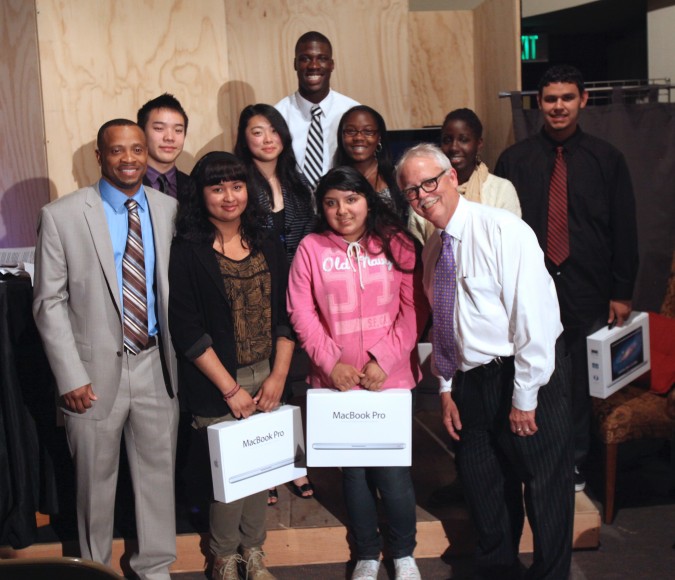
Winners of 2012 Andrew Fluegelman Foundation Fellowship Awards showing off their new Apple MacBook Pro laptop computers, May 18, 2012. Bruce Bouligny on left and David Bunnell in white shirt.
On Friday, May 18, 2012, the day of the Facebook Initial Public Offering of stock, I attended the annual Andrew Fluegelman Foundation Fellowship Awards Gala, held at the Linen Life Gallery at 770 East 14th Street, San Leandro, California USA. Here is the Facebook page for the Andrew Fluegelman Foundation. Bruce Bouligny is the Director of the Fluegelman Foundation.
I learned of this event the morning of the event, thanks to a Facebook status update from Harry McCracken, Editor-at-large at Time Magazine. McCracken encouraged his Facebook subscribers, of which I am one, to attend this event. McCracken also linked to a piece he wrote for Time entitled Remembering Andrew Fluegelman, a Quiet Giant of the PC Revolution that introduced me to Andrew Fluegelman, a man I had not previously heard of. Once I read McCracken’s piece on Fluegelman, I got a ticket for the Awards Gala and attended as a blogger. Amazingly, the tickets were free, although they did ask for a modest donation at the door, which I happily made.
Andrew Fluegelman disappeared in 1986, and it’s assumed he committed suicide by jumping from the Golden Gate Bridge. He was 42, and his body was never found.
I had only been at the Linen Life Gallery for mere minutes when my friend Stuart Sweetow came over to say hello. I recognized him but couldn’t place him, as I only see Sweetow at the Berkeley Entrepreneurs Forum at The Lester Center for Entrepreneurship and Innovation at the Haas School of Business at the University of California at Berkeley. He’s the videographer for the forums, and has been for some 15 years. I have had the privilege of appearing in one of Sweetow’s videos that he created for the Forum.
Sweetow absolutely made my evening.
How so? It turns out that Sweetow runs a business called Audio Visual Consultants. He’s been in business since 1983 — impressive. In 1986 he was hired by PC World, which Fluegelman co-founded with David Bunnell, to produce a video tribute to Andrew Fluegelman.
A few weeks ago, Sweetow was moving his company’s office and studio to new space and he stumbled upon the ancient video cassette he had produced decades earlier. He decided to call David Bunnell, the co-founder of the Andrew Fluegelman Foundation (and PC World Magazine), to ask if he wanted the tape. Bunnell was probably stunned to get Sweetow’s call. The copy PC World received decades ago had been lost. It was thought that it would never resurface. Thanks to Sweetow, the Foundation and presumably PC World has the video again, and it’s been posted to YouTube so a wider audience can view it.
What a heartwarming story. Here’s Sweetow’s video:
I asked Sweetow if I could blog about this story, and he said that I may.
Sweetow then pointed out that David Bunnell was standing near us. Sweetow offered to introduce me, and I accepted.
David Bunnell co-founded PC World Magazine with Andrew Fluegelman. I used to read PC World frequently. Before the Internet, such magazines were required reading for those interested in technology. You read such magazines the way we read websites like TechCrunch and Engadget today. I got to meet a publishing legend Friday night.
Happily, PC World is still in business, with a vibrant online presence in addition to the physical editions of the magazine.
I asked David Bunnell if I could photograph him, and not only did he agree, but volunteered to step outside into the still bright daylight so I could get a well lit portrait of him. Had he not volunteered, I would have directed him outside, as the light there was perfect. The pictures of Bunnell are at the bottom of this post.
I used my Canon 5D Mark II for these photographs, and I uploaded them at full 21 megapixel resolution. Click on the pictures to see them at full size.
Here is what David Bunnell wrote for the official paper program distributed at the event:
“Andrew Fluegelman (1942-1985)
During his brief life, Andrew made major contributions to the booming computer revolution. In addition to co-founding PC World and Macworld magazines, he wrote PC-Talk, the software program that for the first time made it possible for personal computers to exchange data over a phone line.
Believing that PC-Talk should be available to as many people as possible, Andrew came up with the novel idea of simply giving it away and asking people to send in a donation if they liked the program.
Andrew called this method of distributing software, “freeware.” Thousands of other programmers started making their software available this way, which helped the PC industry grow even faster.
Underlying Andrew’s work was his profound belief that personal computers have the power to transform anyone’s life. Whatever a person’s background and circumstance, if they had a computer their lives could be dramatically changed for the better.
With the help of some of Andrew’s other friends, I established the Andrew Fluegelman Foundation to keep his memory alive and to realize his vision that computers can make a dramatic difference.
Working with other nonprofit organizations, we identify outstanding high school seniors who have overcome the challenges of growing up in poor neighborhoods and who have been accepted into university, college or other advanced educational program. They also must demonstrate a desire to “give back” to their communities.
In Andrew’s name, we give these students a Macintosh laptop computer, printer and training in the use of Google applications, courtesy of Google.
So far, all the students who have won Fluegelman Fellowships have gone on to be successful in college. They arepot to us that owning their own Macintosh computers has been a huge part of that success.
I truly believe Andrew would have loved this program, and that his spirit is with us tonight.
–David Bunnell”
Fluegelman in 1982 created PC-Talk, the first dialup communications program for IBM Personal Computers and their clones. Back then, computers were connected via standard wired telephones directly to each other, not by going through central servers run by companies like AOL, Compuserve or Prodigy. Fluegelman distributed PC-Talk at no charge, and encouraged people to copy it and give it to friends. He made money by asking but not requiring that people mail him money via postal mail. He suggested donations of USD $25 and later more. That was a fair amount of money back then. I suspect it still works today, at least on Windows XP.
Fluegelman was the first Editor-in-Chief of PC World magazine. He interviewed Bill Gates in 1984, as shown in this picture from the Fluegelman Foundation’s Facebook page:

Andrew Fluegelman, on the far right, interviewing Bill Gates, standing, in 1984. Photographer unknown.
The Fluegelman Foundation honors Andrew Fluegelman’s memory by awarding Apple MacBook Pro computers to seven deserving high school seniors each year. Fluegelman believed that a computer could change a person’s life, so he would have approved of the work this foundation is doing.
This year Apple MacBooks were awarded to:
- Daniel Rodriguez – Castlemont High School
- Teresa Unique Cole – MetWest High School
- Andranee Nabors – Berkeley High School
- Cara He – Skyline High School
- Rocio Montes – Skyline High School
- Brian Lien – Skyline High School
David Bunnell and Bruce Bouligny took turns reading portions of the winning essays these winners submitted to compete for the laptops. The students were not given a chance at the microphone to say ‘thank you.’ I suspect this was the first time these students had been on stage outside of school. In future years, I suggest the organizers allow each student 60 seconds at the microphone to say thank you. They should be told of this opportunity in advance so they can prepare and practice their remarks. They will likely be nervous, but it should be a condition of winning that they say something. It will be a valuable learning experience to speak before strangers, and it’s one they won’t likely ever forget. The audience I am sure would welcome hearing from the students.
I tried hard to get permission to photograph the winners individually like I was able to photograph David Bunnell and Larry Magid, below. But I didn’t ask soon enough and the time simply ran out. I would have loved the chance to spend two minutes with each student properly photographing them. If I attend next year, I will prepare in advance with the organizers so that I can do this.
The Fluegelman Foundation also gives awards to an outstanding foster parent each year. I did not learn how this award is connected to Fluegelman, and there may be no overt connection. Whether there is or not isn’t important. The evening was an inspiring delight, and I am so glad that I attended.
Two foster parents spoke.
The first foster parent to speak was Tracy Beckham, who has 12 children. Eleven she and her husband adopted after doctors told her they would not be able to conceive and carry to term a biological child. We learned that their youngest child, the girl in the white dress below, is their biological child, and she was conceived naturally with no assistance from the fertility industry. Beckham told us how doctors at first thought she was sick, but eventually concluded she was pregnant. What a happy surprise.

Tracy Beckham with her family plus a few others, May 18, 2012 at Andrew Fluegelman Fellowship Awards Gala. Photo by Kevin Warnock.
Beckham’s 6’6″ son Dorial Green-Beckham, the tallest in the two shots immediately above and below, is already famous, with his own entry in WikiPediA, I learned. The pictures I took of him are likely to get this blog some significant traffic. Thank you Dorial and thank you to his mother Tracy, who gave me permission.
Dorial is a famous high school football player. According to The Columbian Missourian newspaper, Dorian was the most recruited high school football player in the United States in 2012. Here’s a long piece that details how intense this process was.
Dorial signed with the Missouri Mizzou Tigers, after a courtship that lasted years. I had no idea before today that even happened. I don’t follow football, and I only occasionally watch the Super Bowl.
I had never heard of Dorial before this event. I am glad that I met him, and he was gracious and patient as I set up the pictures you see here. I gave him posing directions just like I give the female models I photograph. I wonder what he thought of me given that he’s probably been photographed by hundreds and hundreds of photographers to date.
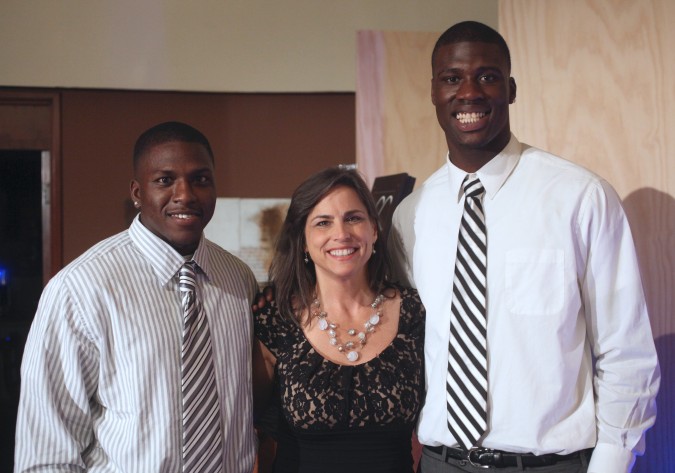
Tracy Beckham with 2 of her 12 children including Dorial Green-Beckham on the right. May 18, 2012 in San Leandro, California. Photo by Kevin Warnock.
Have a look at this YouTube video that shows Dorial breaking the United States national receiving record for high school football.
Here’s a clip of Dorial catching a 79 yard pass with one hand during the 2012 Army All American Game. Looks impressive to me:
Dorial Green-Beckham was awarded the first National Fellowship awarded by the Fluegelman Foundation, and Dorian was given an opportunity to speak to the audience, which he accepted.
The second foster parent to speak was Athaline Burns, shown in the photograph below holding her award plaque for East Bay Foster Parent of the Year.
Burns told the crowd she provided care to about 100 foster children that lived in her home over the years. This is an astonishing and important contribution to society. Burns kept her remarks short, so I don’t have any stories to relate about her remarkable life. I didn’t have the opportunity to talk with her after the event, which I regret. I would like to interview her for this blog at some point, and meet her family to hear about their experiences first hand. I have at times considered becoming a foster parent, so I have more than a casual interest in this subject.
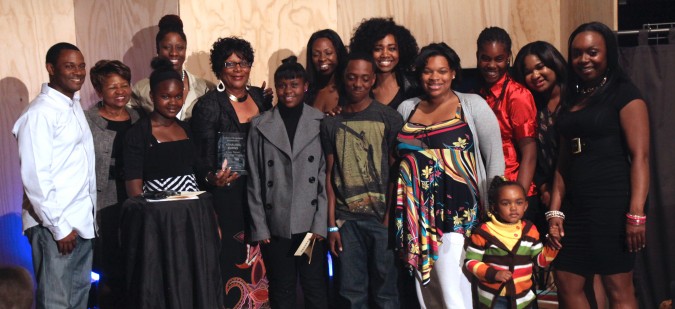
Athaline Burns, holding award plaque, shown with her family. Burns is East Bay Foster Parent of the Year. May 18, 2012 in San Leandro, California. Photograph by Kevin Warnock.
Here is the portrait that I took of David Bunnell and Larry Magid together:
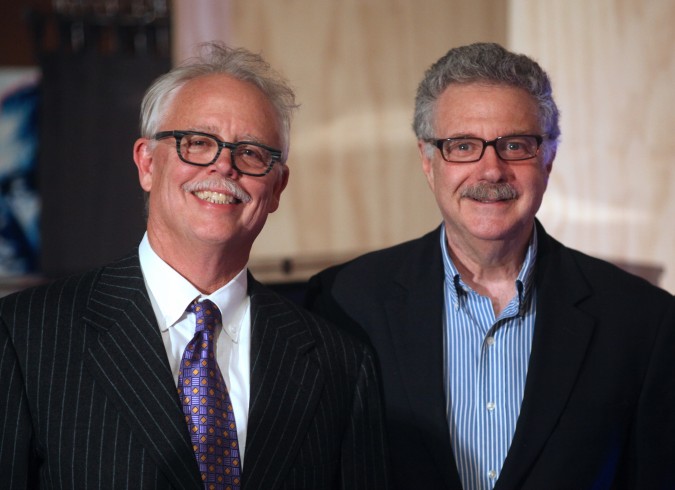
David Bunnell and Larry Magid, May 18, 2012 at Andrew Fluegelman Foundation Fellowship Awards Gala in San Leandro, California. Photo by Kevin Warnock.
Bunnell and Magid provided commentary at the start of the event about the storied life of Andrew Fluegelman. I got the distinct impression that both Bunnell and Magid are elder statesmen in the technology industry, so I am so grateful that I got to photograph them together and separately, and that the results were so pleasing. Magid asked if he could use the results, and I happily told him that he may. Of course, Bunnell may as well, as well as all the others that I photographed. I am very flattered when I encounter my photographs around the web and on other peoples’ Facebook pages. Twenty four of my Facebook friends are also friends with Magid.
Larry Magid is Co-Director of ConnectSafely, a non-profit. Magid provided Gala attendees with free copies of the book A Parent’s Guide to Facebook (also published in Arabic). I have a copy, and from reading part of it I can say it’s well written and likely to be very valuable to parents. I’ve never seen such a lushly produced guide to safely using potentially a potentially dangerous site like Facebook. I plan to read the entire book. Here’s an abstract of what ConnectSafely is about, from the group’s website:
“ConnectSafely is for parents, teens, educators, advocates – everyone engaged in and interested in the impact of the social Web. The user-driven, all-media, multi-platform, fixed and mobile social Web is a big part of young people’s lives, and this is the central space – linked to from social networks across the Web – for learning about safe, civil use of Web 2.0 together. Our forum is also designed to give teens and parents a voice in the public discussion about youth online safety begun back in the ’90s. ConnectSafely also has all kinds of social-media safety tips for teens and parents, the latest youth-tech news, and many other resources.
ConnectSafely.org is a project of Tech Parenting Group, a 501(c)3 nonprofit organization based in Palo Alto, Calif., and Salt Lake City, Utah. The forum is co-directed by Larry Magid of SafeKids.com and Anne Collier of NetFamilyNews.org, co-authors of MySpace Unraveled: What It Is and How to Use It Safely. (Peachpit Press, Berkeley, Calif., July 2006).”
Larry Magid is also the on-air technology analyst for CBS. Magid has over 62,000 subscribers on Facebook.
Here is the portrait that I took of David Bunnell:
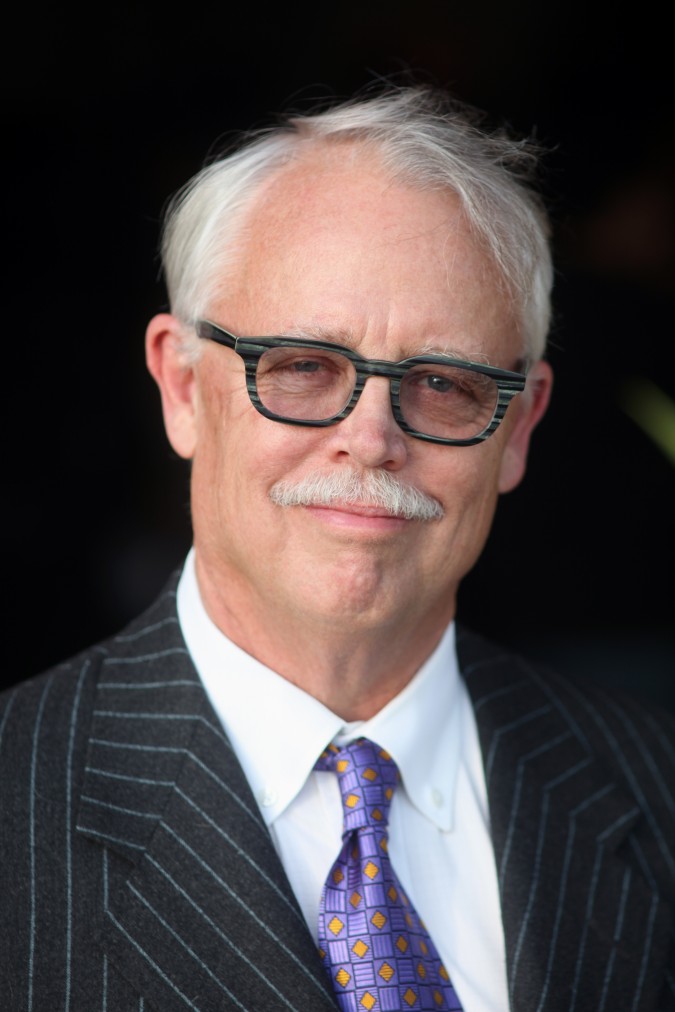
David Bunnell, co-founder of Andrew Fluegelman Foundation, May 18, 2012. Photographed by Kevin Warnock.
Here is the portrait that I took of Larry Magid:

Larry Magid, on-air technology analyst for CBS, photographed May 18, 2012 at the Andrew Fluegelman Foundation Fellowship Awards Gala. Photo by Kevin Warnock.
Here is a photograph of the reception prior to the awards ceremony. The food and drink were outstanding, thanks to B Restaurant and Bar, Trader Joe’s, Markham Vineyards, Carl Talaue Catering, RSVP Catering and T-Rex BBQ.
The Skyline Jazz Band, made of up musicians from Skyline High School, played during the reception. The band’s director is Vincent Tolliver. The musicians are:
- Olivia Ports – Drums
- Ella Pearson – Piano
- David McMillan – Guitar
- Zach Seidl – Bass
- Jeff Seidl – Trombone
- Jeramy Kaetzel – Trumpet
- Andrew Wong-Rolle – Alto Saxiphone
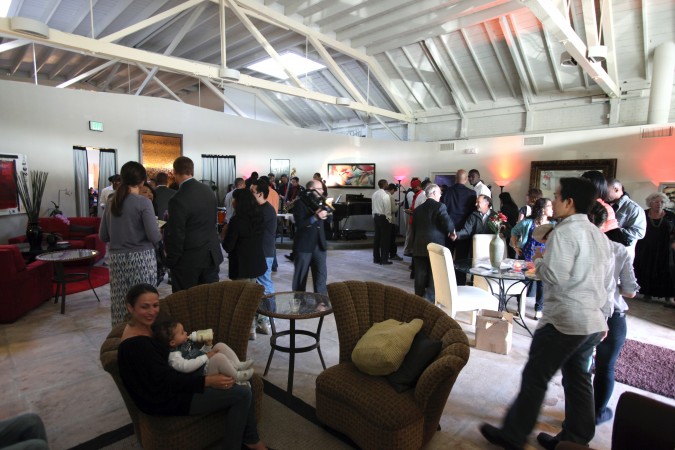
Reception at 2012 Andrew Fluegelman Foundation Awards Gala in San Leandro, California, May 18, 2012. That's Stuart Sweetow in the center holding the video camera.
Charleston Pierce was the Master of Ceremony. I found him vibrant, charismatic and engaging. He said he’s a graduate of San Francisco School of the Arts, or SOTA. This school is located in the same building where I went to high school. That school, J. Eugene McAteer High School, was dissolved in 2002 due to its being atrocious, which I can personally confirm.
SOTA seems to be churning out winners, like Devon Ivie, Havel Weidner and Cristina Rey, all of whom I met in February, 2012 at the San Francisco Mock Trials citywide finals. They were on the student team representing SOTA, which this year competed with Lowell High School, generally thought to be the best public high school in San Francisco. SOTA lost to Lowell this year, but has won over Lowell multiple times in past years. The students I met in February are very polished and impressive, and I predict they will go far in life, unlike most of my McAteer classmates, I am sad to report.
I got to shake Pierce’s hand, but sadly didn’t get to interview him. He’s in the entertainment industry, and I bet he’s somebody my readers would love to learn more about. If he’s reading this, I invite him to contact me to schedule an interview.
Congratulations to all the winners at the 2012 Andrew Fluegelman Foundation Fellowship Awards. To the student winners, I say study hard in college, drink alcohol very moderately or not at all, decline all illegal substances and activities, keep in touch with your professors long after you graduate, and start building and nurturing your personal brand right now, by blogging and Tweeting thoughtfully, articulately and responsibly.
When you graduate, future employers will then have four years (decline the five year program!!!) of your posts to read to get a sense of who you are and why they should hire you. You’ll be far ahead of most of your peers, even your peers that might have better academic credentials than you have earned. In life it’s not just grades, but your character, passion and drive that will advance you past your peers. You can start today with WordPress and your shiny new Macbooks. Good luck, and drop me a line once a year to let me know how your MacBook enhanced lives are going. I will write about you here if you take me up on this.
College will be over in two snaps of your fingers, so relish it, embrace it and blog about it! Have fun.
———-
May 21, 2012 – I added a photo credit to the caption under photograph of Stuart Sweetow, which was taken by Rufus Diamant.
Guest post by my grandmother Edith Lawall – ‘Twasn’t All Bad’
[This post is special. I am transcribing a story my late grandmother Edith Lawall wrote starting on October 29, 1979. She submitted it to a writing contest organized by The Illinois Federation of Women’s Clubs. The organization presented my grandmother on May 9, 1980 with a Certificate of Award for winning Second Place for the Tenth District. Edith Lawall is the mother of my mother Martha Warnock. My grandfather was married to my grandfather Russell Lawall. Here is a PDF format file that contains a scan of the original typed story: Edith Lawall story about 1929 market crash]
‘TWASN’T ALL BAD
The manuscript enclosed is one I wrote in a week’s time, beginning October 29, 1989. (This is the same date the U.S. stock market collapsed 50 years earlier.) For several days prior to this anniversary we were repeatedly informed by the media about this approaching event, which ushered in the Great Depression of Thirties. A quick review of my life at that time indicated it was a particularly exciting time for me too, but in a different sort of way. In my family’s situation little money and no stocks were involved. Immediately I felt impelled to record my memorable recollections. I began the story that day. And so it was.
As it worked out there were two incentives for me to write on this subject: 1. I hoped it might add personal interst for any Mabie family posterity. 2. I wanted to have something to enter in the Annual Creative Writing Contest, sponsored in various categories by the 10th District of Federated Women’s Clubs of Illionois, and possibly, the State Federation Contest. It seemed that the “Crash” was a timely subject, due to tis Worldwide repercussions.
Since my recollections came very easily, I did enjoy writing it, and I suppose I’m the only “Leaf” left on the Mabie-Westcott Family Tree, who might even know about these particular family events.
This “‘Twasn’t All Bad” narritive is being sent to Robert and Martha Warnock in San Francisco, California; David and Willa Samors Lawall of Charlottesville, Virginia; and Gilbert and Sarah Nesbit Lawall in Amherst, Mass. and their families. We hope the grandchildren will read it too.
Edith Roe Mabie Lawall, January 29, 1980
Edith Mabie Lawall
Short Story
2485 Words
Class II
‘TWASN’T ALL BAD
Today is October 29, 1979. Newspapers, television, and radio, have reminded us constantly that it is just fifty years since the Stock Market Crash. Pictures of wild crowds in the streets, and tales of the millions of paper assets which vanished, have been harrowing. Only those fifty-ish and upwards, can remember it, and the succeeding years that were affected by it. However, I am also reminded that it wasn’t all dismal, and I particularly recall one bright spot from this period, which I wish to sketch.
For the Mabie family, our personal Depression had already peaked, and begun to decline. Our scanty assets had never been invested in the Market. Instead, they had gone into higher education necessary for my sister, Helen, and myself, in tune with our desires to reach our musical aspirations. The minister father, Harry Mabie, and devoted wife, Esther, musically inclined themselves, cheerfully supplied the necessary funds, with the result, that by 1929, Helen and I had received Bachelor of Music Degrees, from the University of Cincinnati.
In September of 1929, father received a “call” to the pastorate of the East Baptist Church of Lebanon, Ohio, 25 miles by bus from Cincinnati. Coincidentally, Helen signed a contract to become Music Supervisor of the Bay Villiage Schools, (suburban Cleaveland) and I was made teacher of piano classes in our nearby Madisonville School.
I’ll never forget the thrill of packing the Chevy, full of overflow from our van, (including our pretty white cat); the lovely drive through lush Warren County; and getting settled in our new home. I had secured a suitable place to live in Cincinnati, in the home of one of our church members, near my school. I could go home to Lebanon for weekends and summer vacations. Helen had arrived in Bay Village in time to see many sad situations, following the Crash Day. Numbers of her school children had come from families that had been forced to give up their cherished Lake Shore homes, and seek cheaper living elsewhere. Farewells were hard!
In Lebanon, I was asked to take over the organist’s duties; teach in the Sunday School; and steer the young people’s Sunday Evening group.
An unexpected delight that both Helen and I could enjoy, was the golf course, nearby, where all the privileges were free to the local ministers and their families. A dear friend gave us some of his old clubs, balls were cheap, and we were most happy to get up at sunrise, hike to the Park, avail ourselves of the small mounds of dirt provided for “tees”, and do our practicing. Nearly always, we had the Park and the spacious golf course to ourselves and birds.
On a certain bright Monday morning in July, 1931, all of us rose early, for this was the day Father and Joe, (our adopted 12-year-old brother), were embarking on a combined business and fishing trip. The business entailed a church conference at Green Lake, Wisconsin, for father, with plenty of time on the side, to supervise Joe’s fishing in the Lake. They would camp out, as did many others, and cook their own meals. After an hour of frenzied thought and furious packing, they were off on the grand excursion.
A great calm descended on the household, but not for very long. Mother, Esther Westcott Mabie, was very much interested in family history, and had cherished records from many past generations. A Mr. Whitman, a (distant) Westcott was compiling a history, and he was very grateful for information which Esther had sent him. He wanted to host a reunion of all living Westcotts within reach, and had invited mother. He lived in Milford, N.Y. and had access to historic regions nearby. Mother planned to stay for at least a week, including visits with friends after the reunion. Her departure was scheduled for noon of the next day. There were still many things to be done.
Tuesday morning mother was out, doing errands, and Helen was busy in the kitchen, when the doorbell rang. I answered, and there stood a very personable young man, who introduced himself as Jesse Lyons, a Senior from Wooster College, and part of a “Peace Caravan” representing the American Friends Service Committee. He had gone to the office of our church, and asked where he might find the minister. He told the Secretary that he hoped to make arrangements, for himself and co-student, for a meeting where they could explain the mission of the Caravan. He was referred to our residence, and there he was. I invited him to come in, and explained that the minister was out of town for a week, but I was sure the arrangements could be made. Then he told me he was looking for a place for himself and his co-student Wendell, to stay for a few days. Without a moment’s hesitation, I said, “You can stay here”, and that was it.
Soon mother returned, and she was impressed with his serious interest in the cause of peace. She volunteered to arrange with a lady friend, to stay nights, as a chaperone during her absence. Jesse soon left to pick up his friend Wendell, and offered to help mother for errands, and to drive her to the bus station when needed. Meanwhile, Helen had come in, and she was happy to meet Jesse, and assumed the lunch preparations. And thus began a most delightful 8-day period for us all!
After seeing mother off, we soon worked out a cooperative routine. Naturally, Jesse and Wendell were eager to fall in with our early-rising golf routine, and we had enough clubs for all. Also, they indicated a desire to help with the housework. Jesse chose to do the vacuum cleaning and dusting. Wendell volunteered for dishwashing, in which he claimed exertise from camp experiences. Each would take care of his own washing, and either one would be available for driving to market, and odd jobs. Of course, Helen and I would be the cooks.
Plenty of time was found for long, deep discussions of philosophical problems. W did not ignore the Depression, but neither did we let it disturb us unduly. There were other subjects which we wanted to know about, for instance, how did they get started on this summer activity? We gathered that the Peace Caravan was instigated by the noted Quaker, Rufus Jones. it seemed to have some of the emotional and spiritual drive, that would in later years become the central motivating force of the Peace Corps of the John F. Kennedy era.
Both young men were keenly interested in their College Dramatic Department. A recent performance in which they had participated, was “Death Takes a Holiday”, a semi-serious play putting forth the possibility that there were always people who knew that their time had come, and were praying that it might be as soon as possible.
Another matter about which they were concerned, was their College Fraternity System. Both men belonged to Greek-letter Fraternities, but they were constantly running across fine students who had never been pledged. They felt something should be done about it. Jesse had finally persuaded his fraternity brothers to host a special monthly party for non-pledged people. The parties had been quite successful, and they hoped this would become a part of college activity programs.
One morning after our customary 2-hour period on the golf course, while we sipped cool lemonade, Jesse confided his future plans and problens. For some time he had been considering preparation as a missionary in the foreign field. However, with his uncertain home situation due to the frailty of his mother, he felt that he might set aside those plans, in favor of entering the ministry at home. He also expressed his firm belief in “Providential Guidance”, or “The Inner Light” as the Quakers expressed it. He said that he never made any of his talks, without a preliminary, prayerful meditation hour. Wendell had similar ideals, but apparently had not chosen a life work.
Another day, which turned out to be one of the warmest, around 100 degrees, we spent a part of our leisure time, getting ready for the evening appointment. Helen had been asked to furnish some music for a gathering at the local retirement home for “genteel” widows. She had a number of songs in mind, and seized the opportunity to try them out on us. It was lots of fun. Sometimes we all joined in, and Helen was never happier than when she could play the piano, and go from oone song to another, as fancy chose. Of course, some were appropriate, and some were not, and the decision for the evening finally boiled down to several which we all approved.
Upon our arrival at the lovely antique-filled old home, the hostess suggested that the men would be more comfortable on the front porch, sitting on the porch swing. Helen and I went in and greeted the ladies, who were just entering the parlor. All very pleasant, so far. Then there was the flurry of the arrival of the Cincinnati soloist, accompanied by two friends. They had to be introduced also, but we soon realized that the soloist knew many of the widows, as she had been there before, to sing. Helen ventured a mild remark about the heat wave we were having. The soloist spoke up, “Oh, was it hot today? I never notice the heat”. It was hard to think about what to say next, so we were very relieved when the hostess announced that the program was about to begin. She introduced the Cincinnati soloist, who went to the piano, sat down, and said, “I hope the piano keys are cleaner than they were the last time I was here.” But soon she started to play and sing, and I could see that she was a very gifted person, indeed. We all applauded enthusiastically. Then it was Helen’s turn. She sand “Du bist die Ruh” of Schubert, and the contemporary, “In the Time of Roses”. Then she smiled and announced that the last number would be, “The Big Brown Bear”, which she played and sang with great gusto. Everyone was carried away with the humor of the lyrics, and her original version of the accompaniment. The applause was almost equal to that of the professional. Then the boys were invited in, to tell about their “Caravan”. Jesse told them something of Rufus Jones, and his greatness as a speaker to the students, and the inspirations he, and many others had received. Cooling refreshments were served, we shook hands with everyone, and departed.
All too soon, the day of the “Caravan” departure arrived. One more early golf game, then breakfast and packing. We expressed our appreciation to them, as they did to us, and off they went!
When Helen and I returned to the kitchen, there were the breakfast dishes, neatly stacked in the sink, but no Wendell to wash them. We were both suffering an acute attack of Self-Pity. We sat down by the kitchen table, looked at each other, and burst into tears. Each of us had known that the let-down would have to come. We knew all along that the “Caravan” was like a ship that passed in the night, but oh, how much fun and inspiration we had enjoyed. Memories would last — well, probably longer than the Depression, and we were most thankful they were all happy memories.
Our return to normalcy was helped very much by two unexpected dinner invitations for the next two nights, from friends in our church. These were to honor former church members, visiting from New York. The next day, as Father, Mother and Joe returned from their vacations, we were ready to resume our regular routine also.
One good thing about writing a factual story about fifty years ago, is that it is possible to know, not just surmise, the sequel.
In June, 1933, when Helen came home for summer vacation, she was accompanied by a devoted girl friend, her brother Wilfred, and his best friend, Russell Lawall. Russell was about to be side-tracked for the rest of his life, by meeting me. Fortunately, he had a good job with the A.T.&T. Co for which he was well qualified by being a graduate of Earlham College, and holding a degree from Case Institute in Cleaveland. He was also a Birthright Quaker. The result of this and other visits, culminated in our lovely Quaker wedding in August. We immediately took up our residence in Detroit. Signs of business stagnation were evident everywhere. But we were very happy, and still are, forty-seven years later. I was often mindful of my good fortune in having learned about the Quaker’s tenets from our “Peace Caravan” students.
We had three children: Martha in July of 1934; David in August of 1935; and Gilbert in September of 1936. They were, and still are, a great joy to us. We moved in 1944 to Oberlin, Ohio and Russell commuted to work in Cleaveland. In 1957, he was transferred to Cincinnati, and it was while living there that I heard about Jesse Lyons again. I was waiting in a dentist’s office, and picked up a newspaper to read, and happened to see the church notices. One was headed, “New minister to be installed.” I soon saw that the new minister was Dr. Jesse Lyons, who would take his place the following Sunday, as one of the Staff Ministers at the Riverside Baptist Church in New York. Immediately, I knew there could be but one Jesse Lyons! And I was right!
Several years later, we were saddened to hear that a younger sister of my father, was dying of cancer in a New York hospital. It was sad to think of Janet, a gifted writer, alone in a big city in her last days, and I decided to write to Jesse and see if he could get someone to call on her. I also wrote about the death of my sister, Helen, of cancer in March of 1949. He responded with a beautiful letter, saying how well he remembered the week in Lebanon in 1931. He reported that he had delegated a staff member, a lady who was particularly good at cheering and counseling people, to carry out my request. Later she reported to him that she had found Janet weak, but still a most vibrant and interesting person, and they had talked together for an hour.
A half century later, how can we evaluated our present situation, so plagued with seemingly insoluable dilemmas in high places, as well as low? At least we can remember that God works in mysterious ways His wonders to perform, in season and out of season, in bad times as well as good. We must have steadfast faith that a better world will eventually emerge!
Note — This is a factual story, written entirely from my own memory.
January 25, 1980
Edith Roe Mabie Lawall
[Note from Kevin Warnock, the author of this blog — My grandmother lived in the village of Wilmette, Illinois USA when she wrote this story, at 711 Greenleaf, a house I will always remember from my many happy visits there. My grandmother Edith passed away in 1989 and my grandfather Russell passed away in 1994. I inherited his cherished grandfather clock, which I proudly display in my dining room at my house in San Francisco, California.]
Man drowns after jumping into river to save his girlfriend from her sinking car, even though she had already made it to safety
This story made me cry. Here’s an excerpt:
“Authorities say the Tennessee River’s current was swift when 25-year-old Christopher Heaton jumped in the water to rescue his girlfriend.
Heaton, of Jasper, Tenn., had driven to Bridgeport, Ala., to meet his girlfriend Tuesday evening. He arrived at their meeting place near a boat ramp to see her car sinking as it was swept down the river, said Jackson County Chief Deputy Rocky Harnen. Witnesses told police Heaton immediately dived into the water.
But the woman — whom police haven’t named — escaped from the car and was helped from the water by fisherman at a ramp only 20 yards away, Harnen said.”
It’s so sad that his girlfriend was alive and well just 20 yards away!
I know how powerful love can be, and I might well have jumped in the river as Heaton did had I discovered my ex-wife’s car sinking in the river. When I was married to her I was so in love with her that I believe I would have thrown my normal caution to the wind. Now that I’ve divorced her I don’t know how I would react, as she’s less important to me now. But that doesn’t mean she is unimportant to me and that I would definitely not jump in, because part of me still loves her.
I have a smart father
I like to think I am a smart and inventive guy.
I have two professional claims to fame:
I created the first online document assembly website (Hotpaper) and the first online office suite (gOffice).
Both of these categories of software proved to be quite popular.
In the United States, LegalZoom and Rocket Lawyer now dominate the online document assembly business.
In the United States, Google Docs and Zoho now dominate the online office productivity business.
I am proud that I created the first versions of these significant components to the fabric of the Internet.
While my contributions to the Internet may not have the sex appeal of the social network Facebook or the political influence of the micro-blogging website Twitter, my contributions do allow people to get real work done online.
Getting work done is important to the advancement of humanity. Friending and Tweeting also help advance humanity, but the importance of writing and communicating well with the help of productivity software and document assembly software should not be discounted. How long could you go without Microsoft PowerPoint, Word and Excel or their new online competitors? Probably not long if you are a white collar worker.
I bought a nice house in San Francisco with the spoils of my inventions, and I believe I lead a comfortable and richly satisfying life.
I am shockingly happy. I am surprisingly happy for Google, Zoho, LegalZoom and RocketLawyer — despite their making more money from my innovations than I did.
However, I am not smart like my father Robert Warnock.
Yesterday I learned that my father’s paper Hamilton-Jacobi Equation is included on the peer-reviewed ScholarPedia website.
ScholarPedia is a WikiPedia like website for scientific papers.
Creating an online office suite like I did is a piece of cake compared to what my father works on. Many smart 20 year olds today could build the software I was first to build. But I don’t think any 20 year old could write the papers my father writes, no matter how hard they tried.
Don’t think I am putting myself down by this post.
I am simply showing you how outstandingly bright my father is. My mother is also outstandingly bright, and I’m certain I got my smarts from them.
I regard myself as quite smart.
I continue to invent things on a weekly basis. My mind is frequently dreaming up improvements to many everyday problems. I will never have the time to implement even a small portion of all the crazy ideas I come up with. The best I can hope for is to write a minority of them down and publish them to this blog, where hopefully others will find and then implement them.
I am devoting considerable energy to developing ideas to improve the efficiency of living, including heating, cooling, food production and water usage. Look for many more thoughts from me on these subjects over the coming years. My hope is that my ideas in these areas will have a profound influence on the state of the human condition by the end of my life.
As a side note, I am impressed that Scholarpedia uses Web Fonts to display math equations. That means you can copy and paste the mathematical equations in articles published on Scholarpedia. You generally can’t do this on WikiPedia, where equations are entered as LaTeX source code but then converted to image files for display.
Russell Lawall, my grandfather, as painted by Masako Miyata in the 1970s
In the 1970s, my grandfather Russell Lawall visited Japan with his wife Edith Lawall. Russel and Edith were my mother’s parents.
Russell and Edith had a strong fondness for Japan. They did not speak Japanese, so they arranged in the early 1970s for a local Japanese tour guide and interpreter to show them Japan. That guide, Masako Miyata, truly befriended my grandparents, and they invited her to move to the United States to live with them and go to college, as Masako was in her early 20s at the time.
Masako studied painting and ceramics at The Art Institute of Chicago. She lived with my grandparents for years — I’m guessing five years. Masako went on to marry an American and became of Professor of Art and Art History at James Madison University. She is now Professor Emeritus of Art and Art History. Her husband, Steve Zapton, also holds the same title at the same institution. Masako’s full name is Masako Miyata Zapton.
Masako created dozens of ceramics pieces while she was a student. When my grandfather Russell passed away in 1994, five years after my grandmother Edith passed away, my mother called Masako to see if she wanted the dozens of items back. My grandfather Russell had saved them all, and they were all on display in the family room.
Masako said she did not want her old student work, but that she also did not want any of it to go to strangers, apparently because the works were signed by her and she was not proud of her early examples.
She said family could keep as many pieces as they wished, but that she wanted the rest to be conclusively destroyed, not sold at an estate sale, donated or otherwise disposed of.
It fell on me to destroy Masako’s student artwork. I wore a full face protective shield to protect me from flying chips of fired clay while I used a hammer to smash dozens of vases, bowls and sculptures, while my brother captured video on my Sony Hi-8 camcorder, which I still have but no longer use.
I kept the best examples of Masako’s work, and I have them at my house and at my parent’s house.
My most precious Masako piece of artwork is a portrait she painted in oils of my grandfather Russell.
This portrait of my grandfather is shown above. Click on the picture twice to see a much larger version of it that is so detailed you can see the brush strokes.
While it may look like an abstract painting, it shows a striking resemblance to my grandfather if you stand far enough away from it.
This painting is framed and in perfect condition. I did not need to retouch the above photograph, which I shot within the last month for this blog.
It is characteristic for me to name people I reference in this blog by their first and last name, and then to make future references in the same post by last name only. I have chosen to reference Masako by her first name throughout because even as an art student, she signed her work with just her first name, and she is known professionally as an artist even now by just her first name, to my knowledge.
Thank you Masako for the artwork. And thank you for helping my grandparents for so many years. You were very kind to them, and I appreciate your kindness.
My grandmother Elsie Battaglia featured in Regal Courier newspaper
As I have reported, my dear grandmother Elsie Battaglia turned 100 years old December 12, 2011. Her friends, Ron and Eleanor Highet, owners of the Original Pancake House, threw her a wonderful birthday party, attended by 75 of Battaglia’s friends and family.
Barbara Sherman, a reporter from the Tigard, Oregon USA newspaper the Regal Courier, was among the guests, and she wrote a amazingly wonderful article about the party and my grandmother’s fascinating life. I only learned about the newspaper article today, however, it was published December 29, 2011.
I learned from this article that my grandmother was proposed to on her first date after 15 minutes of conversation with the young man.
I have known for ages that Grandma was proposed to on the first date, but only today did I learn the proposal happened so quickly.
15 minutes! Think about that for 15 minutes.
[Important note: Since this blog will be around longer than the article will likely be available on the Regal Courier website, I made a screen capture of the story, presented here as a PDF format file:
Regal Courier newspaper story about Elsie Battaglia, December 29, 2011
Please read the article on the newspaper’s website, and ignore the PDF screen captures until the newspaper’s link no longer functions, or the newspaper no longer exists.
This blog will live on for centuries, thus this precaution against an important link getting broken.
It is critical you read the story at the newspaper’s website, as that’s how the newspaper makes money. If you read my PDF before the newspaper deactivates the link, you are stealing from the newspaper’s bank account, which is not kind given how kind they were to feature my grandmother’s birthday party.]
Elsie Battaglia’s 100th birthday party at The Original Pancake House in Portland, Oregon
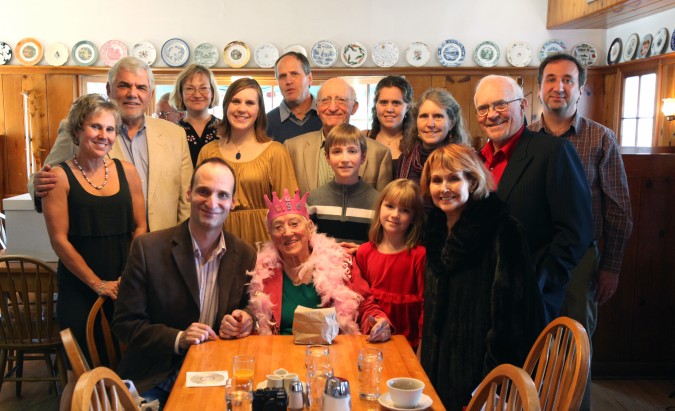
Elsie Battaglia's 100th birthday party at The Original Pancake House, 8601 SW 24th Avenue, Portland, Oregon, USA, December 12, 2011
This morning my young at heart grandmother Elsie Battaglia celebrated her 100th birthday party. She was born on this day in 1911! Seventy five of her friends and family joined her at The Original Pancake House. Battaglia has been friends with the proprietors of this business since 1950.
In the photo above, I’m sitting to the left of my grandmother.
My grandmother Elsie Battaglia’s 100th birthday party coming up December 12, 2011
Yesterday, November 21, 2011, I received a paper invitation from my beloved 99 year old grandmother Elsie Battaglia to her 100th birthday party, which is scheduled for December 12, 2011, next month. I scanned the invitation for you to see. I direct your attention to left side of the graphic, which is the front of the invitation. The right side of the graphic is the interior of the folded invitation.
The text on the left illustrates the strides the world has made in the last 100 years.
I love my grandmother Elsie so much. I’ll be at her birthday party, and I’ll share the highlights with my readers here on my blog.
If you’re having trouble reading the text, click on the invitation graphic to enlarge it dramatically.
Elsie is on Facebook. She had WebTV in 1997. Her now disabled and unused email address was elsie97@webtv.com. She had her Volkswagon Bug in the mid 1950s. Her first son (my father) picked it up for her in Paris, France and had it shipped back to Portland, Oregon, where no doubt it was one of the first in the United States.
Introducing FaceSeat to remotely attend weddings and funerals
Since Apple iPad tablet computers have forward and rear facing video cameras, and are set up for slick and easy video conferencing, I have a proposal:
Make iPads available for check out in hospitals and nursing homes, so that patients can receive ‘hospital visits’ from their friends and family more frequently.
I bet that if a scientific study were conducted that patients would get well sooner and be happier if they could video chat with their friends and family for free, even if they didn’t own or know how to operated a computer. I suspect the video chatting on the iPad is so easy to use that nurses and doctors could be trained to be trainers in mere minutes.
I suspect there are already robust WiFi networks in care facilities, so the networking is already in place.
While we’re at it, install permanent video cameras at all funeral homes so people can attend even if too far away to travel.
For that matter, install video cameras at churches and other places where weddings take place, so more people can attend weddings.
For an extra dose of ‘being there’ somebody could create a holder for an iPad that would look sort of like a person from the sholders up. Where the face would be, place the iPad. This iPad holder could be clipped to the back of a chair or bench.
This way a church, wedding venue or funeral home might have 10 ‘remote seats’ available, where one iPad equals one seat. When someone is occupying a seat at home, their face is shown full screen on the remote iPad. In this way, the physically present attendees can see the faces of the remote guests, and the relatives will be comforted that more friends and family could attend.
Since all these iPads cost money, I suppose it would be OK for wedding and funeral venues to charge extra for these virtual seats. But I would say just give them away at first, to get people hooked on the concept. It’s such a far out idea I am doubtful people would pay until they had seen it done at another event.
I read once that when the grocery shopping cart was invented and placed in stores that nobody touched them. The proprietor had to hire pretend shoppers to push them around as if they were really shopping. That educated actual shoppers, who began to use the carts themselves for real. I think something similar might be required to get this idea off the ground. It might even be necessary to hire fake guests who do not know the wedding party or the deceased, to virtually attend the wedding or funeral, cry and be present.
I’ve read that in Japan there are businesses that rent actors to attend weddings in person to give the impression the bride and groom have more friends than they really do. So there is a precedent for fakery like this.
I think the idea of virtually attending important life events is a good one. Especially going forward with jet fuel being so expensive and security standards getting stricter. It just isn’t a great idea to fly all over the planet for all these events, and such travel I predict will one day become politically incorrect.
There are so many ways to make my idea more like being there. The iPads could be mounted on motorized tripod mounts the remote user could adjust, so people could look to their sides and say hello to real people. The iPad has a camera on the back already, so people could see who was sitting behind them. Maybe two iPads could be mounted back to back so that people sitting in the back could see who was sitting up front in the virtual seats.
Lots of people miss lots of important events. My idea is much more social than simply installing some anonymous cameras that might be security cameras as far as the attendees are aware. With my idea, people present physically can interact with people present virtually.
I dub my idea FaceSeat.
Of course, this concept is applicable to zillions of events beyond weddings and funerals, but at first I would focus on these big markets — a lot of people marry and die in the world.
With the provocative name FaceSeat I could get sued by Apple and FaceBook at once. Think of the stunning PR that would result – instant mind share. If Oprah [Winfrey] still had a popular daytime television show, I’d be on it within days of the lawsuits being filed.
PS — This is just a wacky idea I’m writing on my blog! I am not jumping into to the videoconferencing industry. If someone has already thought of and published my idea, I’d like to know about it so I can update this post.
